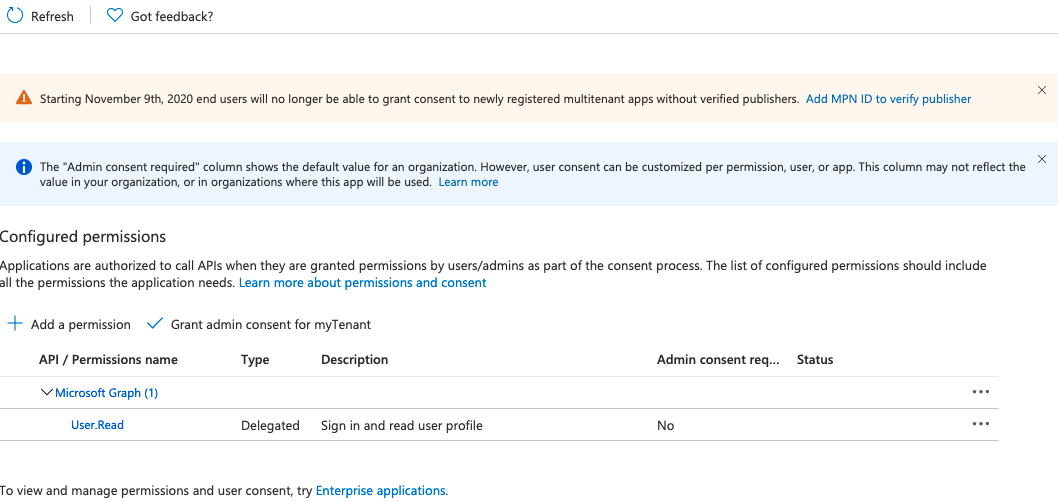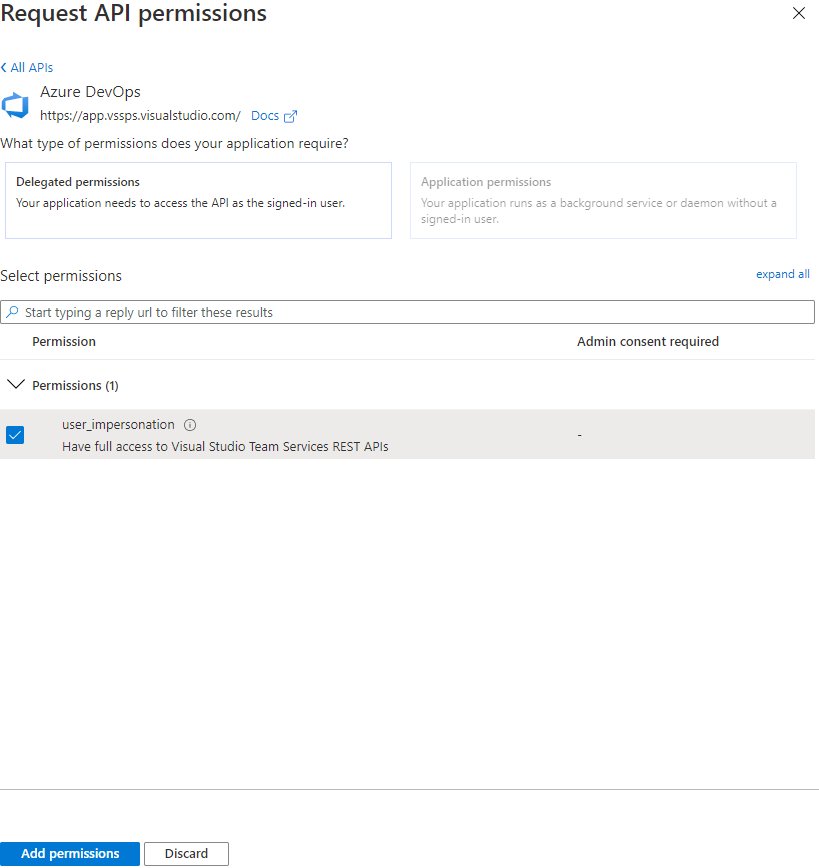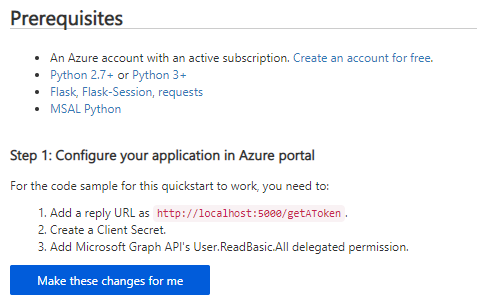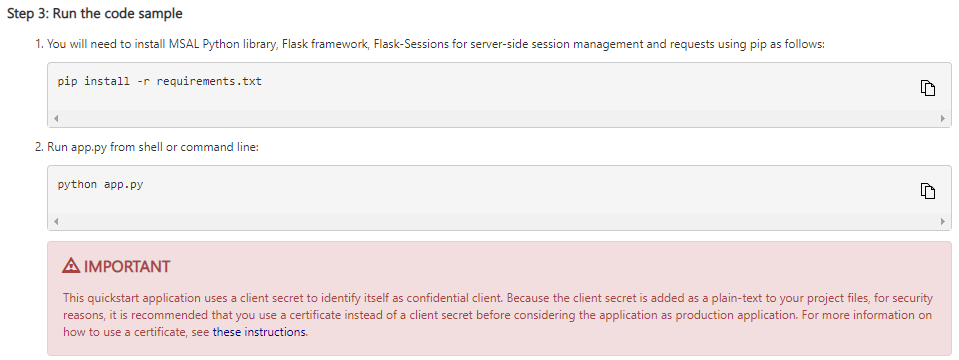Manage personal access tokens (PATs) using REST API
Azure DevOps Services
When you own a large set of personal access tokens (PATs), it might become complex to manage the maintenance of these tokens using the UI alone.
With the PAT Lifecycle Management API, you can easily manage the PATs associated with your organizations using automated processes. This rich set of APIs lets you manage your PATs, allowing you to create new PATs and renew or expire existing PATs.
Important
We recommend using Microsoft Entra tokens. For more information about our efforts to reduce PAT usage, see our blog. Review our authentication guidance to choose the appropriate authentication mechanism for your needs.
In this article, we show you how to configure an application that authenticates with a Microsoft Entra token and makes calls with the PAT Lifecycle API.
Important
You can't use service principals or managed identities to create or revoke PATs.
Prerequisites
Unlike other Azure DevOps Services APIs, users must provide an Microsoft Entra access token to use this API. Given this API’s ability to create and revoke PATs, we want to ensure that such powerful functionality is available only to safer Microsoft Entra tokens.
To acquire and refresh Microsoft Entra access tokens, you must do the following:
- Have a Microsoft Entra tenant with an active Azure subscription
- Register an application in their Microsoft Entra tenant
- Add Azure DevOps permissions to the application
- Get consent from tenant admin: Depending on your tenant's security policies, your application might need permissions to access resources in the organization. Request a tenant administrator to grant permission to the app to use it within your tenant.
Important
"On-behalf-of application" solutions (such as the “client credential” flow) and any authentication flow that does not issue a Microsoft Entra access token is not valid for use with this API. If multifactor authentication is enabled in your Microsoft Entra tenant, you must definitely use the "authorization code” flow.
Once you have an application with a working authentication flow for handling Microsoft Entra tokens, you can use these tokens to make calls to the PAT Lifecycle Management API.
To call the API directly, provide a Microsoft Entra access token as a Bearer token in Authorization header of your request.
For more information and a full list of the available requests, see the PAT API reference.
In the following section, we show how to create an app that authenticates a user with a Microsoft Entra access token. The app uses the Microsoft Authentication Library (MSAL) and calls our PAT Lifecycle Management API.
Clone our Python Flask web app
We provided you with a sample Python Flask web application for this API that you can download on GitHub and configure to use with your Microsoft Entra tenant and Azure DevOps organization. The sample application uses the MSAL authorization code flow to acquire a Microsoft Entra access token.
Important
We recommend getting started with the sample Python Flask web application on GitHub, but if you prefer to use a different language or application type, use the Quickstart option to recreate an equivalent test application.
Once you clone the sample app, follow the instructions in the repo’s README. The README explains how to register an application in your Microsoft Entra tenant, configure the sample to use your Microsoft Entra tenant, and run your cloned app.
Generate a Quickstart Azure portal application
Instead, you can generate a sample app with the generated MSAL code using the Quickstart option on the application's page in Azure portal. The Quickstart test application follows the authorization code flow, but does so with a Microsoft Graph API endpoint. Users need to update the application's configuration to point to the endpoint for the PAT Lifecycle Management API.
To follow this approach, follow the Quickstarts instructions for the application type of your choice on the Microsoft Entra ID Develop docs homepage. We walk through the following example with a Python Flask Quickstart app.
Once you register your application in a Microsoft Entra tenant with an active Azure subscription, navigate to your registered application under Microsoft Entra ID -> App Registrations in the Azure portal.

Select your application and navigate to API Permissions.

Select Add a permission and select Azure DevOps -> select the appropriate scopes you need. In this case, the PAT Lifecycle Management APIs only support user_impersonation, but other APIs may request different more granular scopes that you can find on each API's individual reference page. Once all the scopes are selected, click Add permissions.

Select Quickstart.
Select your application type: for Python Flask, select Web application.
Select your application platform. For this tutorial, select Python.
Make sure you meet the necessary prerequisites, then allow Azure portal to make the necessary changes to configure your application. The reply URL is the redirect URL that was set at application creation + “/getAToken”.

Download the Quickstart application and extract the files.

Install the application requirements and run the application to ensure you have all necessary dependencies. The application is initially configured to hit an endpoint in the Microsoft Graph API. Learn how to change this endpoint to the PAT Lifecycle Management API base endpoint by following the configuration instructions in the following section.

Configure a Quickstart application
Once the user downloads and installs the Quickstart application, it gets configured to use a test API endpoint from Microsoft Graph. Modify the generated configuration file to have it call the PAT Lifecycle Management API instead.
Tip
We use collection and organization interchangeably in these docs. If a configuration variable needs a collection name, please replace it with your organization name.
Do the following tasks:
- Update the ENDPOINT configuration variable to
https://vssps.dev.azure.com/{YOUR_COLLECTION_NAME_HERE}/_apis/Tokens/Pats?api-version=6.1-previewfor the PAT Lifecycle Management APIs - Update the SCOPE configuration variable to "499b84ac-1321-427f-aa17-267ca6975798/.default" to refer to the Azure DevOps resource and all of its scopes.
The following example shows you how we did this configuration for the Quickstart Python Flask application we generated through the Azure portal in the previous section.
Make sure you follow instructions to secure your client secret, which is initially inserted in plain-text into the application configuration file. As a best practice, remove the plain-text variable from the configuration file and use an environment variable or Azure KeyVault to secure their application's secret.
Instead, you can choose to use a certificate instead of a client secret. Using certificates is the recommended option if the application gets used in production. The instructions for using a certificate can be found in the final step of the Quickstart application setup.
Caution
Never leave a plain-text client secret in production application code.
Once you download your Quickstart application, install its dependencies, and test that it runs in your environment, open the
app_config.pyfile in your editor of choice. The file should resemble the following code snippet; for clarity, comments referencing the default Microsoft Graph API configuration were removed:import os CLIENT_ID = "YOUR_CLIENT_ID_HERE" # Application (client) ID of app registration CLIENT_SECRET = "YOUR_CLIENT_SECRET_HERE" # Placeholder - for use ONLY during testing. # In a production app, we recommend you use a more secure method of storing your secret, # like Azure Key Vault. Or, use an environment variable as described in Flask's documentation: # https://flask.palletsprojects.com/en/1.1.x/config/#configuring-from-environment-variables # CLIENT_SECRET = os.getenv("CLIENT_SECRET") # if not CLIENT_SECRET: # raise ValueError("Need to define CLIENT_SECRET environment variable") AUTHORITY = "https://login.microsoftonline.com/YOUR_AAD_TENANT_ID_HERE" # For multi-tenant app # AUTHORITY = "https://login.microsoftonline.com/Enter_the_Tenant_Name_Here" REDIRECT_PATH = "/getAToken" # Used for forming an absolute URL to your redirect URI. # The absolute URL must match the redirect URI you set # in the app's registration in the Azure portal. ENDPOINT = 'https://graph.microsoft.com/v1.0/users' SCOPE = ["User.ReadBasic.All"] SESSION_TYPE = "filesystem" # Specifies the token cache should be stored in server-side sessionUpdate the client ID or client secret to your application with your app registration’s client ID and client secret. When in production, make sure to secure the client secret by using an environment variable, Azure KeyVault, or by switching to a certificate.
CLIENT_ID = "YOUR_CLIENT_ID_HERE" # Application (client) ID of app registration CLIENT_SECRET = "YOUR_CLIENT_SECRET_HERE" # Placeholder - for use ONLY during testing. # In a production app, we recommend you use a more secure method of storing your secret.Change the
ENDPOINTvariable to your Azure DevOps collection URL and API endpoint. For example, for a collection named "testCollection," the value would be:# Fill in the url to the user's ADO collection + the PAT lifecycle management API endpoint here ENDPOINT = 'https://vssps.dev.azure.com/{YOUR_COLLECTION_NAME_HERE}/_apis/Tokens/Pats?api-version=6.1-preview'For a collection named "testCollection," this endpoint would be:
ENDPOINT = 'https://vssps.dev.azure.com/testCollection/_apis/Tokens/Pats?api-version=6.1-preview'Change the
SCOPEvariable to reference the Azure DevOps API resource; the character string is the resource ID for the Azure DevOps API, and the.defaultscope refers to all scopes for that resource ID.SCOPE = ["499b84ac-1321-427f-aa17-267ca6975798/.default"]If your application is configured for a specific tenant (rather than the multitenant configuration), use the alternate value for the
AUTHORITYvariable, adding the specific tenant name in "Enter_the_Tenant_Name_Here."# For single-tenant app: AUTHORITY = "https://login.microsoftonline.com/YOUR_AAD_TENANT_ID_HERE" # For multi-tenant app: AUTHORITY = "https://login.microsoftonline.com/Enter_the_Tenant_Name_Here"Verify that the final
app_config.pyfile matches the following, with your CLIENT_ID, tenant ID, and collection URL. For security reasons, ensure that the CLIENT_SECRET was moved to an environment variable, Azure KeyVault, or swapped with a certificate for your registered application:import os CLIENT_ID = "YOUR_CLIENT_ID_HERE" # Application (client) ID of app registration # Note that the CLIENT_SECRET has been removed and moved to an environment variable or Azure KeyVault AUTHORITY = "https://login.microsoftonline.com/YOUR_AAD_TENANT_ID_HERE" # For multi-tenant app # AUTHORITY = "https://login.microsoftonline.com/Enter_the_Tenant_Name_Here" REDIRECT_PATH = "/getAToken" # Used for forming an absolute URL to your redirect URI. # The absolute URL must match the redirect URI you set in the app's registration in the Azure portal. ENDPOINT = 'https://vssps.dev.azure.com/testCollection/_apis/Tokens/Pats?api-version=6.1-preview' # Used to configure user's collection URL and the desired API endpoint SCOPE = ["499b84ac-1321-427f-aa17-267ca6975798/.default"] # Means "All scopes for the Azure DevOps API resource" SESSION_TYPE = "filesystem" # Specifies the token cache should be stored in server-side sessionRerun the application to test that you can GET all PAT tokens for the requesting user. Once verified, you can modify the contents of
'app.py'and the'ms-identity-python-webapp-master\templates'directory to support sending requests to the rest of the PAT lifecycle management API endpoints. For an example of a Python Flask Quickstart application that was modified to support requests to all PAT lifecycle management API endpoints, see this sample repo on GitHub.
Automatically refresh a Microsoft Entra access token
Once the application is configured correctly and the user acquired an access token, the token can be used for up to an hour. The MSAL code provided in both previous examples automatically refreshes the token once it expires. Refreshing the token prevents the user from needing to sign in again and acquire a new authorization code. However, users might need to sign in again after 90 days once their refresh token expires.
Frequently asked questions (FAQs)
Q: Can I get an example of this sample application for another language/framework/application type?
If you have a request for an example, head over to our Dev Community to see if someone else has an example to share. If you have a sample application that you’d like to share to the larger Azure DevOps audience, let us know and we can look into circulating it on these docs more widely!
Q: What is the difference between this token API and the token admin API?
This token API and the token admin API, while similar, serve different use cases and audiences:
- This token API is largely for users who want to manage the PATs that they own in an automated pipeline. This API allows. It gives you the ability to create new tokens and update existing ones.
- The token admin API is meant for organization admins. Admins can use this API to retrieve and revoke OAuth authorizations, including personal access tokens (PATs) and self-describing session tokens, of users in their organizations.
Q: How can I regenerate/rotate PATs through the API? I saw that option in the UI, but I don’t see a similar method in the API.
The 'Regenerate' functionality available in the UI actually accomplishes a few actions, which are fully replicable through the API.
To rotate your PAT, do the following steps:
- Understand the metadata of the PAT using a GET call,
- Create a new PAT with the old PAT’s metadata using a POST call,
- Revoke the old PAT using a DELETE call
Q: I see a "Need admin approval" pop-up when I try to proceed with using this app. How can I use this app without admin approval?
It seems that your tenant has security policies, which require your application to be granted permissions to access resources in the organization. At this moment, the only way to proceed with using this app in this tenant is to ask an admin to grant permission to the app before you can use it.
Q: Why am I seeing an error like "Service principals aren't allowed to perform this action" when I try to call the PAT Lifecycle Management API using a Service Principal or Managed Identity?
A: Service Principals and Managed Identities aren't permitted. Given this API’s ability to create and revoke PATs, we want to ensure that such powerful functionality is given to allowed users only.